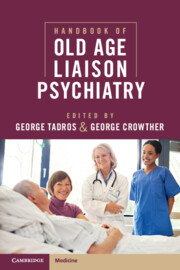Book contents
- Handbook of Old Age Liaison Psychiatry
- Handbook of Old Age Liaison Psychiatry
- Copyright page
- Contents
- Contributors
- Introduction
- Chapter 1 Psychological Well-Being in Later Life
- Chapter 2 The Epidemiology of Mental Illness in Older People in Acute Hospitals
- Chapter 3 Elderly-Friendly Care Settings and Hospitals
- Chapter 4 Communication with Older People
- Chapter 5 Privacy and Dignity in Acute Hospitals
- Chapter 6 Liaison Psychiatry and Law
- Chapter 7 Safeguarding Adults
- Chapter 8 Carers’ Needs before, during, and after Hospital Admissions
- Chapter 9 Dementia and Related Disorders
- Chapter 10 Behavioural and Psychological Symptoms of Dementia in Hospital Settings
- Chapter 11 Liaison Old Age Psychiatry Management of Delirium in Acute Hospitals
- Chapter 12 Depression and Associated Disorders
- Chapter 13 Prevention of Suicide and Self-Harm in Older People
- Chapter 14 Fear and Anxiety in Acute Settings
- Chapter 15 Late-Onset Psychosis and Related Disorders
- Chapter 16 Drug and Alcohol Misuse in Older People
- Chapter 17 Perioperative Medical Management of Older People
- Chapter 18 Parkinson’s Disease and Related Disorders in Acute Hospitals
- Chapter 19 Comprehensive Geriatric Assessment in Clinical Practice
- Chapter 20 Interface between Liaison Psychiatry Services for Older People and Wider Community Services
- Chapter 21 Psychometric Measures in Old Age Psychiatry
- Index
- References
Chapter 1 - Psychological Well-Being in Later Life
Published online by Cambridge University Press: 04 April 2024
- Handbook of Old Age Liaison Psychiatry
- Handbook of Old Age Liaison Psychiatry
- Copyright page
- Contents
- Contributors
- Introduction
- Chapter 1 Psychological Well-Being in Later Life
- Chapter 2 The Epidemiology of Mental Illness in Older People in Acute Hospitals
- Chapter 3 Elderly-Friendly Care Settings and Hospitals
- Chapter 4 Communication with Older People
- Chapter 5 Privacy and Dignity in Acute Hospitals
- Chapter 6 Liaison Psychiatry and Law
- Chapter 7 Safeguarding Adults
- Chapter 8 Carers’ Needs before, during, and after Hospital Admissions
- Chapter 9 Dementia and Related Disorders
- Chapter 10 Behavioural and Psychological Symptoms of Dementia in Hospital Settings
- Chapter 11 Liaison Old Age Psychiatry Management of Delirium in Acute Hospitals
- Chapter 12 Depression and Associated Disorders
- Chapter 13 Prevention of Suicide and Self-Harm in Older People
- Chapter 14 Fear and Anxiety in Acute Settings
- Chapter 15 Late-Onset Psychosis and Related Disorders
- Chapter 16 Drug and Alcohol Misuse in Older People
- Chapter 17 Perioperative Medical Management of Older People
- Chapter 18 Parkinson’s Disease and Related Disorders in Acute Hospitals
- Chapter 19 Comprehensive Geriatric Assessment in Clinical Practice
- Chapter 20 Interface between Liaison Psychiatry Services for Older People and Wider Community Services
- Chapter 21 Psychometric Measures in Old Age Psychiatry
- Index
- References
Summary
This chapter seeks to promote both awareness and understanding of evidence-based psychosocial factors that enhance well-being, adjustment, and recovery in older people admitted to hospital.
The chapter begins by exploring ageing from biological, psychosocial, and existential perspectives. It then focusses upon the psychological sequel of illness and disability in this population and goes on to identify components of psychological well-being drawn from both qualitative and quantitative research studies that promote recovery in older people who have been admitted to hospital.
The chapter also explores the role of culture, faith, and ethnicity in the well-being of hospitalised older people and concludes by highlighting essential components in the development of a positive, recovery-focused culture of care.
- Type
- Chapter
- Information
- Handbook of Old Age Liaison Psychiatry , pp. 9 - 23Publisher: Cambridge University PressPrint publication year: 2024

